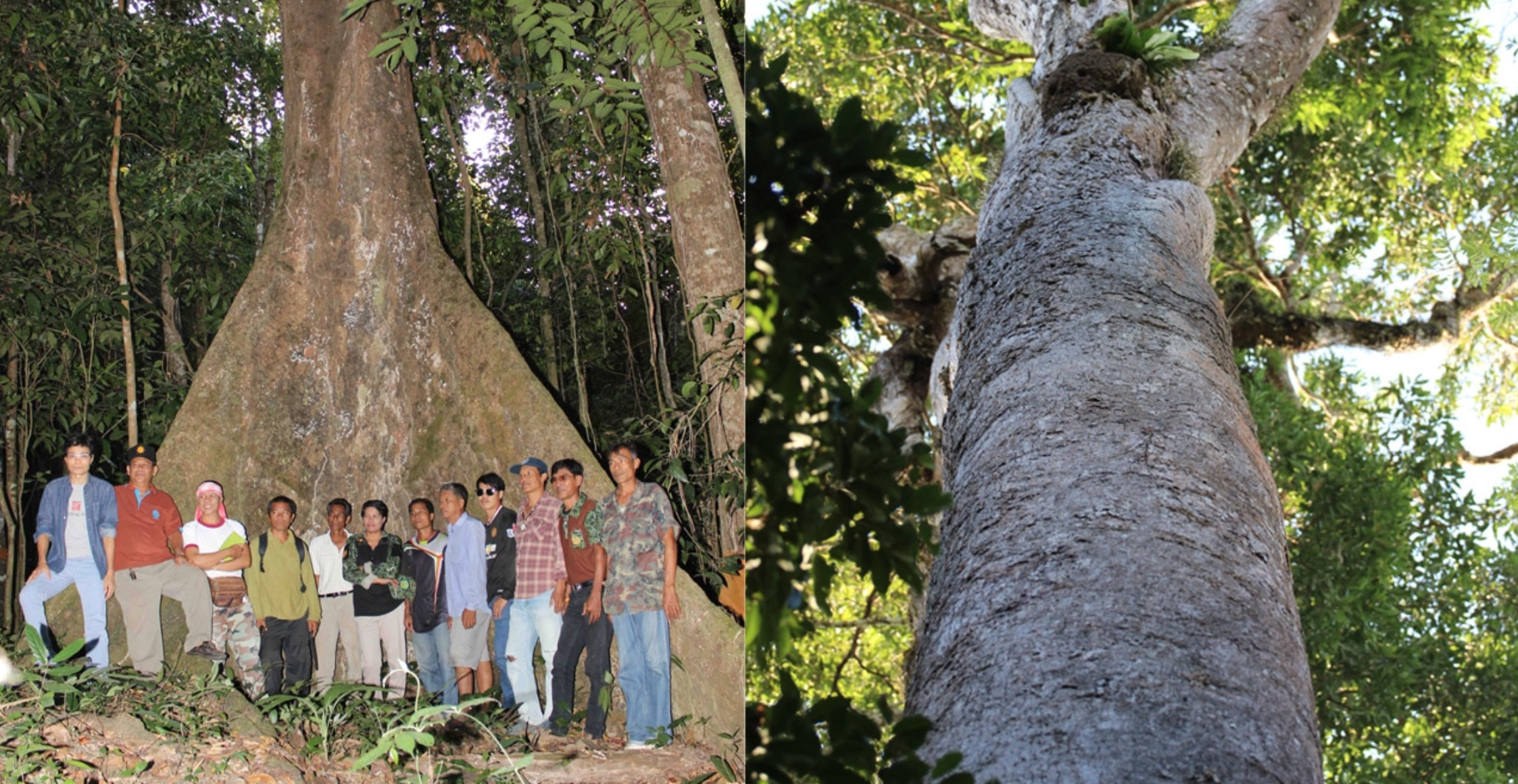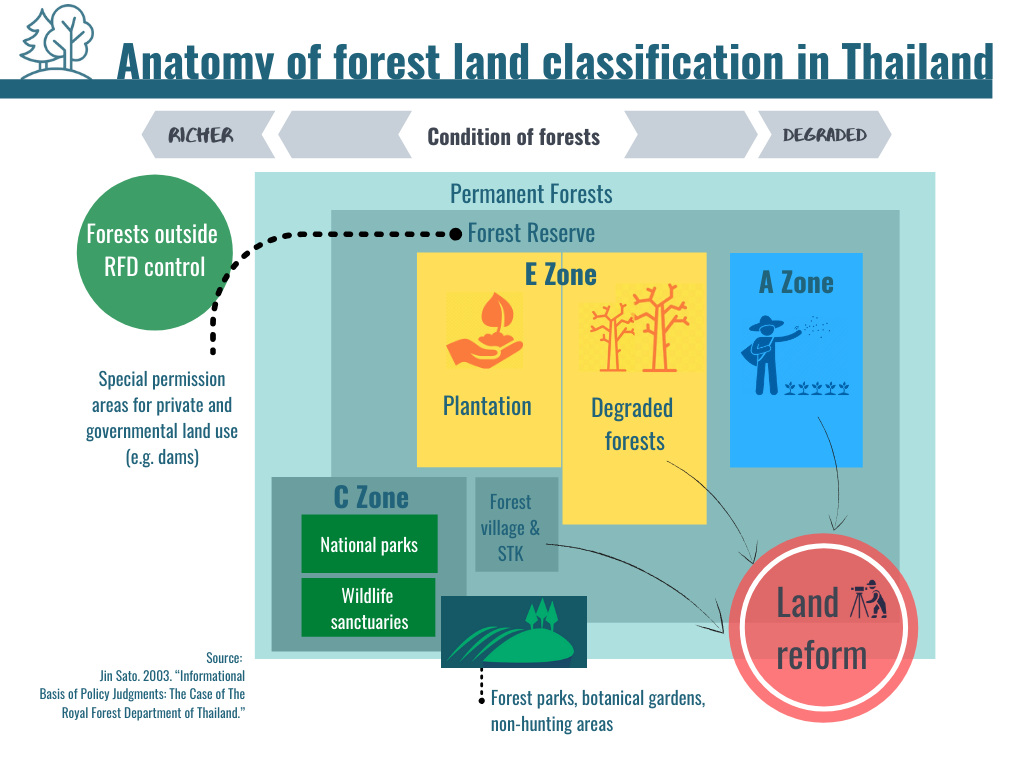Forestry Laws, Plans and Policies
- 2017 Constitution of the Kingdom of Thailand
- 1941 Forest Law
- 1961 National Parks Law (amended 2019)
- 1964 National Reserved Forest Law
- 1985 National Forest Policy (currently under the revision in 2020)
- 1989 Logging Ban1
- 1992 Wildlife Conservation Law (amended 2019)
- 1992 Forest Plantation Law and its revisions
- 2002 Chainsaw Law
- 2010 Regulation of the Prime Minister’s Office on the Issuance of Community Land Title Deeds
- National Economic Social and Development Plan: 2017-2021
- 2019 Community Forestry Law
Thailand’s forests are governed under a system of laws and policies that has evolved over the past few decades to place a greater emphasis on conservation and sustainable management. Though challenges of implementation, participation, and community usage rights persist, 2 governance can be considered a positive factor in Thai forest health. 3
How are Forests Defined?
“Forest” has a general meaning in Thai law unrelated to tree cover, while “reserved forest” has a more particular meaning, but again not necessarily tied to tree cover. Under both the 1941 Forest Act and the 1964 National Reserved Forests Act, “Forest” means essentially all public land, whether or not it is forested. 4 However, “reserved forest,” “national park,” and “wildlife sanctuary,” are among the official (and in some cases overlapping) designations of public land,5 any one of which can but need not contain physical forest, and which have varying degrees of protection associated with them. Furthermore, particular species are also recipients of special protection. Meanwhile, various government plans target increasing forest cover, with a current target of 40% of land area.6
Again, some authors call any public land “legal forest,” in keeping with the 1941 and 1964 laws.7 This totals some 41 million hectares. Of that, some 23 million hectares are designated as “Forest Reserves” or “Reserved Forests.” These forests generally have more restrictions on activities in them than non-demarcated forest (see “Permitted Activities” below).
The 1985 National Forest Policy created further sub-categories of land within Reserved Forests: Conservation (C) Zones where no extraction or settlement whatsoever is permitted, Economic (E) Zones where some economic activity such as plantation forestry and/or timber harvesting is allowed, and Agricultural (A) zones whose dominant use is agriculture. The Royal Forest Department (RFD) has used this flexibility to recognize the claims of settlements that pre- or post-date establishment of reserves, without recognizing full title.8
A helpful graphical representation bof the various land designations below from Sato (2003) is reproduced.9
Two separate categories of public land with stronger protection are national parks and wildlife sanctuaries. As of 2019, there were a reported 6.7 million hectares of land in 100 designated national parks, and roughly 1 million hectares in 23 proposed new parks. There were also roughly 3.6 million hectares of land in 56 designated wildlife sanctuaries, with a further 13,400 hectares of land in 2 new proposed sanctuaries.10 Acts amending both the National Parks and Wildlife Protection Act were passed in the spring of 2019 and will take force in November. Most significantly, forest parks and botanical gardens will now receive the same protections as national parks, and penalties for various wildlife crimes will increase.11
Under the 1992 Law on Commercial Forest Plantations of exotic species can be established in degraded parts of Reserved Forests by the Forest Industry Organization (FIO), or on private lands with a permit.12 Reserved Forests today therefore contain a mix of natural forest and plantations.13
Who holds Primary Responsibility for Managing the Forests?
Two departments of the Ministry of Natural Resources and Environment currently divide responsibility for managing forests. The Royal Forest Department (RFD) manages Reserved Forests and oversees private commercial plantations. The Department of National Parks, Wildlife and Plant Conservation (DNP) manages National Parks and Wildlife Sanctuaries, including the forests in them. Both share responsibility with the national police for enforcing criminal provisions of the laws governing their respective territories.
The RFD is organized with staff at the provincial, district, and Reserved Forest level.14 Its provincial and district staff report in part to provincial governors and district officials who fall within the Ministry of Interior.15
RFD’s responsibilities include:
- Designing management plans for each Reserved Forest.
- Issuing permits for gathering forest products
- Enforcing laws and regulations governing Reserved Forests.
Community Forestry
Forest-dwelling and adjacent communities have long advocated for formal legal recognition of their customary title to land that has been officially designated as reserved forest or protected area. They have had limited success to date. For many years, RFD has recognized some 7,000 community forests (while perhaps another 3,000 existed without formal recognition) in which communities were granted rights to gather only non-timber products for household uses.16 Until recently, there was next to no legal basis for this arrangement.17
Thailand’s REDD Readiness Documents to the Forest Carbon Partnership Facility reference section 19 of the Reserved Forests Act, which grants the Director General of RFD catch-all powers to manage forests.18 The 2011 Prime Minister’s Regulation on the Issuance of Community Land Title Deeds allowed communities to apply for rights to use but not possess state-owned land. It also required periodic re-registration.19
However, in February 2019, the National Assembly passed a Community Forest Act, which will take effect in November. The act permits the formal recognition of community usage rights and management responsibilities in reserved forest areas, although the government retains all possessory rights.20 Furthermore, the act does not recognize any community usage rights in National Parks, Wildlife Sanctuaries, or other protected areas.21
A recent legal assessment of the Community Forest Act affirms that the Community Forest Act is a crucial step to strengthen formal recognition of the role of communities in managing forests, outside of protected forest areas. In its analysis, it identifies a significant gap in the law, which is that community members are only allowed to use forest products for subsistence, but not for commercial purposes.22

Community Forest in Tha Sae, Chumphon Province, Source: Thai Rath, CC-BY-NC-SA 3.0.
What Activities are Permitted in Forests, and by Whom?
Occupying any public land is officially forbidden, though in practice, “land occupation in non-demarcated legal forests is [only] prohibited on hills, mountains, and within the lowest 40 m. at the foot of a hill or mountain.”23
Under the 1964 Reserved Forests Act any logging or collection of forest products in Reserved Forests requires a permit.24 The 1941 Forest Act also creates two protected species of timber no matter where they are found: Category A species, which would require a permit to harvest (this includes teak), and Category B, for which no permit ordinarily would be granted, absent special approval from the ministry.25 However, no timber harvesting of any native species has been allowed from public lands since the 1989 logging ban.
Also, occupying or using land in Reserved Forests for agriculture is illegal according to the 1964 law, with some exceptions: 1) those whose occupation or use predates the demarcation of a particular area of Reserved Forest and apply for recognition within 90 days of land being designated forests, and 2) those granted concessions or other special permission to use or reside on land. These exceptions, and the E and A zones described above are very significant, given the sizable population that resides in land classified as Forest Reserves.
Under the 1961 National Parks law, no collection or harm to any natural resource, including plant life, is permitted in a national park, and no occupation is permitted.26 These are tighter restrictions than on reserved forests and have been challenged, given the one million people estimated to live in national parks.27 Similar restrictions apply under the 1992 Wildlife Protection Act.28
Table 1: Primary Organizations and Forest-Related Responsibilities
| Name | Main Responsibilities | |
|---|---|---|
| Ministry of Natural Resources and Environment | Houses RFD, FIO and DNP. | |
| Royal Forest Department | Government agency within MNRE responsible for overseeing forest sector and managing state-owned forests outside of protected areas.29 | |
| Forest Industry Organization | State-owned timber company that manages some plantations. | |
| Department of National Parks, Wildlife and Plant Conservation | Manages protected areas. | |
| Ministry of Agriculture and Cooperatives | Oversees commercial rubber tree plantations. | |
| Ministry of Interior | Oversees much of provincial, district and sub-district governments, who play a large role in natural resources management decisions. Also has investigative units who investigate reports of illegal logging.30 | |
| Ministry of Commerce | Customs department checks legality of wood imports and exports. |
Last update: 31 August 2021
References
- 1. The summary is that the Cabinet approved the Minister of Agriculture and Cooperatives to cancel all concession grants of restricted wood, (except the mangrove concession). Under the Forest Act B.E. 2484, all concessions ended entirely as proposed and approved by the Ministry of Agriculture and Cooperatives.
- 2. Voices for Mekong Forests. 2018. “Assessing Forest Governance in Thailand.” Accessed October 2019.
- 3. Food and Agriculture Organization. 2017. “Forest Change in The Greater Mekong Subregion (GMS): An overview of negative and positive drivers.” Accessed October 2019.
- 4. Kingdom of Thailand. 1941. Forest Act, B.E. 2484 (1941).” Accessed October 2019. The Forest Act states: “In this Act: (1) ‘Forest’ means land which is not acquired by any person under Land Code.” The National Reserved Forests Act, B.E. 2507 (1964) states: “In this Act “forest” means the land which includes mountain, creek, swamp, canal, marsh, basin, waterway, lake, island and seashore which has been taken up or not acquired by a person in accordance with the law.”
- 5. EU FLEGT Facility. 2011. “Baseline Study 5, Thailand: Overview of Forest Law Enforcement, Governance and Trade.” Accessed October 2019.
- 6. Office of the National Economic and Social Development Board. 2017. “The Twelfth National Economic and Social Development Plan (2017-2021).” Accessed October 2019.
- 7. Jean Phillipe LeBlond. 2019. “Revisiting forest transition explanations: The role of “push” factors and adaptation strategies in forest expansion in northern Phetchabun, Thailand.” Accessed October 2019.
- 8. Jin Sato. 2003. “Informational Basis of Policy Judgments: The Case of The Royal Forest Department of Thailand.” Accessed October 2019.
- 9. Ibid. Accessed October 2019.
- 10. Protected Planet. “World Database on Protected Areas: Thailand.” Accessed October 2019.
- 11. Tanadee Pantumkomon and Praew Annez. Tilleke & Gibbins. 2019. “Updates to Thailand’s Environmental Laws.” Accessed October 2019.
- 12. Kingdom of Thailand. 1992. “Commercial Forest Plantations Act, B.E.2535 (1992).” Accessed October 2019.
- 13. Jean Phillipe LeBlond. 2019. “Revisiting forest transition explanations: The role of “push” factors and adaptation strategies in forest expansion in northern Phetchabun, Thailand.” Accessed October 2019.
- 14. Jin Sato. 2003. “Informational Basis of Policy Judgments: The Case of The Royal Forest Department of Thailand.” Accessed October 2019.
- 15. Ibid. Accessed October 2019.
- 16. Rights and Resources Initiative. 2012. “Thailand: General Comments.” Accessed October 2019.
- 17. Ibid. Accessed October 2019.
- 18. Kingdom of Thailand. 2013. “Readiness Preparation Proposal (R-PP) (revised).” Accessed October, 2019.
- 19. Rights and Resources Initiative. 2012. “Thailand: General Comments.” Accessed October 2019.
- 20. Rina Chandran. Reuters. 2019. “Thai Community Forest Bill Won’t Benefit All, Campaigners Say.” Accessed October 2019.
- 21. Ibid. Accessed October 2019.
- 22. Nathalie Faure. RECOFTC. 2021. Legal assessment of Thailand Community Forest Act shows ways to strengthen regulations. Accessed August 31, 2021.
- 23. Jean Phillipe LeBlond. 2019. “Revisiting forest transition explanations: The role of “push” factors and adaptation strategies in forest expansion in northern Phetchabun, Thailand.” Accessed October 2019.
- 24. Kingdom of Thailand. 1964. “National Reserved Forests Act, B.E. 2507 (1964).” Accessed October 2019.
- 25. Kingdom of Thailand. 1941. “Forest Act, B.E. 2484 (1941).” Accessed October 2019.
- 26. Kingdom of Thailand. 1961. “National Park Act, B.E. 2504 (1961).” Accessed October 2019.
- 27. EU FLEGT Facility. 2011. “Baseline Study 5, Thailand: Overview of Forest Law Enforcement, Governance and Trade.” Accessed October 2019.
- 28. Kingdom of Thailand. “Wildlife Conservation and Protection Act, B.E. 2535 (1992).” Accessed October 2019.


